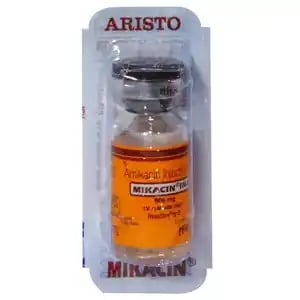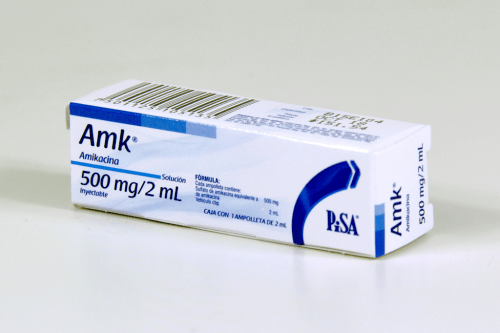Similar Medicine Of Omnikacin 500 Injection 2ml
Discover the Benefits of ABHA Card registration
Simplify your healthcare journey with Indian Government's ABHA card. Get your card today!
Create ABHAIntroduction to Omnikacin 500 Injection 2ml
Omnikacin 500 Injection 2ml is a potent aminoglycoside antibiotic designed to combat severe bacterial infections. Each 2 ml vial contains 500 mg of amikacin sulfate, the active ingredient renowned for its efficacy against a broad spectrum of Gram-negative bacteria. This medication is primarily administered in hospital settings under the supervision of healthcare professionals to ensure optimal patient outcomes.
How Omnikacin 500 Injection 2ml works
Amikacin, the active component of Omnikacin, functions by binding to the 30S ribosomal subunit of susceptible bacteria. This binding interferes with protein synthesis, leading to the production of defective proteins and ultimately causing bacterial cell death. Its mechanism of action makes it particularly effective against bacteria resistant to other antibiotics.
How To Use Omnikacin 500 Injection 2ml
- Omnikacin 500 mg Injection is administered either intramuscularly or intravenously.
- The dosage and duration are determined based on the type and severity of the infection, patient weight, age, and renal function.
- For adults with normal kidney function, the typical dosage is 15 mg/kg/day, divided into two or three equal doses.
- It's crucial to complete the full prescribed course, even if symptoms improve, to prevent the recurrence of the infection.
Special Precautions About Omnikacin 500 Injection 2ml
- Before initiating treatment with Omnikacin, inform your healthcare provider if you have Kidney Disorders: Amikacin is primarily excreted through the kidneys; impaired renal function can lead to accumulation and increased risk of toxicity.
- Inform your healthcare provider if you have Hearing Issues: Aminoglycosides, including amikacin, have been associated with ototoxicity.
- Inform your healthcare provider if you have Neuromuscular Disorders: Conditions like myasthenia gravis or Parkinson's disease may be exacerbated.
- Inform your healthcare provider if you have Pregnancy or Breastfeeding: Amikacin may pose risks to the fetus and is excreted in breast milk.
Benefits Of Omnikacin 500 Injection 2ml
- Broad-Spectrum Efficacy: Omnikacin 500 Injection 2ml is effective against a wide range of Gram-negative bacteria, including multidrug-resistant strains.
- Rapid Bactericidal Action: Quickly reduces bacterial load, crucial in severe infections.
- Synergistic Potential: Can be combined with other antibiotics for enhanced effect.
- Established Safety Profile: Widely studied with well-documented usage guidelines.
Side Effects Of Omnikacin 500 Injection 2ml
- Common side effects include: Nausea and Vomiting: Gastrointestinal disturbances may occur but are typically mild, Injection Site Reactions: Pain, redness, or swelling at the administration site.
- Serious side effects: Nephrotoxicity: Potential kidney damage, especially with prolonged use or high doses, Ototoxicity: Hearing loss or balance issues due to inner ear damage, Neurotoxicity: Symptoms like muscle twitching, seizures, or respiratory difficulties.
What If I Missed A Dose Of Omnikacin 500 Injection 2ml
- If a dose is missed of Omnikacin Injection, contact your healthcare provider promptly to establish a new dosing schedule.
- Do not double the dose to compensate for the missed one.
Health And Lifestyle
Drug Interaction
- Other Aminoglycosides: Increased risk of nephrotoxicity and ototoxicity.
- Loop Diuretics (e.g., Furosemide): Enhanced ototoxic effects.
- Neuromuscular Blocking Agents: Potential for increased neuromuscular blockade.
Drug Food Interaction
- No significant food interactions have been identified with Omnikacin.
- However, maintaining a consistent diet and hydration level is advisable.
Disease Explanation

Omnikacin is utilized to treat severe bacterial infections, including: Respiratory Tract Infections: Such as pneumonia caused by susceptible bacteria. Urinary Tract Infections: Complicated infections resistant to other treatments. Intra-abdominal Infections: Including peritonitis and abscesses. Septicemia: Bloodstream infections that can lead to sepsis. Skin and Soft Tissue Infections: Severe infections like cellulitis or infected burns. Its broad-spectrum activity makes it a valuable option in treating multidrug-resistant bacterial infections.
Safety Advice for Omnikacin 500 Injection 2ml
- High risk
- Moderate risk
- Safe

If a doctor prescribes it, patients with liver issues can safely use it.

Those with kidney condition should use it cautiously. In certain people, a dose modification might be necessary.

One should not consume alcohol while taking this medicine as it has side effects.

Taking this medicine may cause dizziness; drive only if you are alert.

The doctor will only prescribe it if the advantages outweigh the possible concerns if you are pregnant.

See your doctor before taking it if you are nursing a baby. Only if the advantages of this medication exceed the possible risks will the doctor provide a prescription for it
Tips of Omnikacin 500 Injection 2ml
- Adherence: Complete the full course of Omnikacin Injection as prescribed to prevent resistance.
- Monitoring: Attend all scheduled appointments for laboratory tests to monitor drug levels and organ function.
- Communication: Report any unusual symptoms or side effects to your healthcare provider immediately.
FactBox of Omnikacin 500 Injection 2ml
- Drug Class: Aminoglycoside Antibiotic
- Route of Administration: Intravenous (IV) / Intramuscular (IM)
- Uses: Severe bacterial infections (UTI, pneumonia, sepsis, skin infections)
- Dosage: 15 mg/kg/day (varies based on condition)
- Prescription Required: Yes
- Pregnancy Category: Use with caution
- Common Side Effects: Nausea, vomiting, injection site pain
- Serious Side Effects: Kidney toxicity, hearing loss, nerve damage
- Drug Interactions: Loop diuretics, neuromuscular blockers, other aminoglycosides
- Storage: Below 25°C, away from light
- Duration of Use: Typically 7-10 days
Storage of Omnikacin 500 Injection 2ml
- Temperature: Store Omnikacin 500 mg Injection at room temperature (25°C), away from direct sunlight and moisture.
- Refrigeration: Avoid freezing the injection.
- Container: Keep it in its original packaging to protect it from light.
- Accessibility: Store out of reach of children and pets.
- Disposal: Do not use expired injections. Dispose of them as per local medical waste disposal guidelines.
Dosage of Omnikacin 500 Injection 2ml
- The dosage varies depending on the infection severity, patient age, weight, and kidney function:
- Adults & Adolescents (with normal kidney function): 15 mg/kg/day of Omnikacin Injection in divided doses (every 8 or 12 hours).
- Neonates & Infants: 10 mg/kg as a loading dose, followed by 7.5 mg/kg every 12 hours.
- Renal Impairment: Dose adjustments are required based on creatinine clearance levels.
Synopsis of Omnikacin 500 Injection 2ml
Omnikacin 500 mg injection 2 ml is a broad-spectrum aminoglycoside antibiotic used to treat severe bacterial infections, including respiratory, urinary tract, skin, and blood infections. It works by inhibiting bacterial protein synthesis, leading to bacterial cell death. Administered via IV or IM injection, it is prescribed in hospital settings. Regular kidney and hearing function monitoring is essential due to potential nephrotoxicity and ototoxicity risks.
FAQ's on Omnikacin 500 Injection 2ml
What is Omnikacin 500 mg Injection used for?
Is Omnikacin an antibiotic?
How is Omnikacin administered?
How quickly does Omnikacin work?
Can Omnikacin be used for viral infections like flu?
Is Omnikacin safe for kidney patients?
Does Omnikacin cause hearing loss?
Can pregnant women take Omnikacin?
Is it safe for breastfeeding mothers?
Can Omnikacin be given to children?
What should I do if I miss a dose?
Can I stop Omnikacin if I feel better?
Does Omnikacin interact with other drugs?
What are the serious side effects of Omnikacin?
Can Omnikacin be used for pneumonia?
What foods should I avoid while taking Omnikacin?
Is Omnikacin safe for elderly patients?
Does Omnikacin cause allergic reactions?
How is Omnikacin different from other antibiotics?
How long is Omnikacin treatment?
How should Omnikacin be stored?
 Written By
Written By
Priyanka Sonkushre
Content Updated on
Wednesday, 16 April, 2025
















